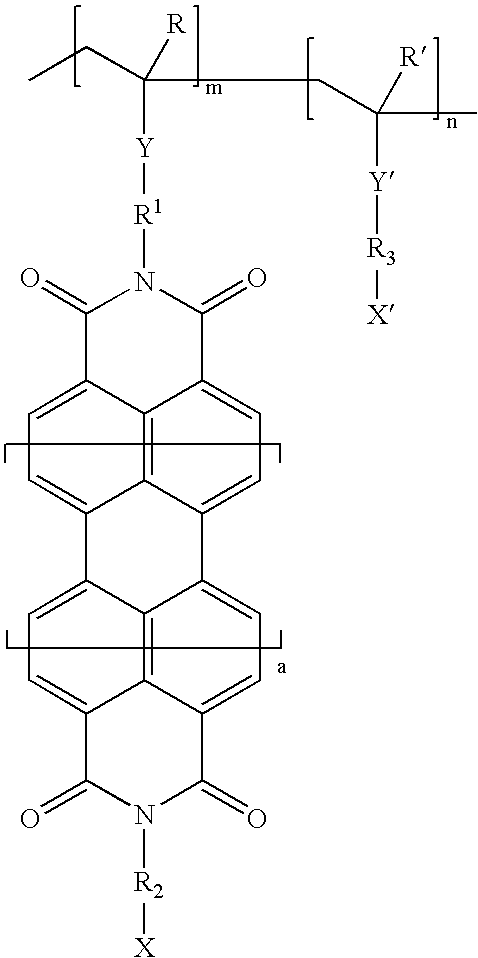Vinyl polymer photoconductive elements
a polymer and photoconductive element technology, applied in the field of electrotrophotography, can solve the problems of irregular image defect, and affecting the quality of images produced with photoconductive elements, and achieve good resistance to injection, thick and uniform, and resist the effect of hole transpor
- Summary
- Abstract
- Description
- Claims
- Application Information
AI Technical Summary
Benefits of technology
Problems solved by technology
Method used
Image
Examples
example 1
[0137] A photoconductive element is prepared substantially as described in Comparative Example 1, except that the barrier layer polymer is Polymer 1. The barrier layer solution is prepared at 10 wt % in tetrahydrofuran. The crosslinking agent and catalyst amounts were added as shown below in Table 1.
TABLE 1Formulation of Polymer 1Amilan ™Lot no.SolidsControlFormulation 1Amilan ™Amilan ™30 gCM8000Polymer 10.917%11.004 g Trixene BI 79630.080% 0.96 gK-kot Xc-C2270.003%0.036 gTOTAL WEIGHT30 g12SurfactantSF102310 drops
[0138] Trixene BI 7963 and K-kot Xc-C227 were obtained from Baxenden Chemicals Limited, Paragon Works, Baxenden, Nr. Accrington, Lancashire. BB5 2SL, United Kingdom. The Polymer 1 layer was web coated at a dry coverage of 0.05, 0.10, 0.20, and 0.30 g / ft2, the Amilan™ layer at 0.05 g / ft2. The samples were cured at 135° C. for 24 hours. They were overcoated with CGL and CTL as described in Comparative Example 1.
Evaluation
[0139] The films are tested in a laboratory appara...
example 2
[0141] A photoconductive element is prepared from Polymer 2 for use in dip coating. The barrier layer solution is prepared at 10 wt % in toluene. The crosslinking agent and catalyst amounts were added as shown in Table 3. An Amilan™ control prepared by web coating as described in Comparative Example 1 was overcoated in the same way as Polymer 2.
TABLE 3Formulation of Polymer 2ComponentWeight (g)Polymer 226.7Trixene BI 79633K-kot Xc-C2270.3Toluene270
[0142] The toluene solution contained 10 wt % solids of a total solution weight of 300 g or a total solution volume of 344 mL.
[0143] Nickel coated polyethylene terephthalate (7 mil) was dip coated into the solution of Polymer 2 and cured at 130° C. for 1 hour to give a dry layer of 0.65 microns. The polymer film was dipped a second time in the Polymer 2 solution to give a dry layer of 1.4 microns after curing. The process was repeated a third time to produce a total film thickness of 2 microns.
[0144] The barrier layers were dipped into...
example 3
Extraction of Naphthalenebisimide from Crosslinked Coatings
[0146] A photoconductive element is prepared from Polymer 3 for use in dip coating. The barrier layer solution is prepared at 10 wt % in tetrahydrofuran. The crosslinking agent and catalyst amounts were added as shown in Table 5. An Amilan™ control prepared by web coating as described in Comparative Example 1 was overcoated in the same way as Polymer 3.
TABLE 5Formulation of Polymer 3ComponentWeight (g)Polymer 324.92Trixene BI 79632.8K-kot Xc-C2270.28THF252
[0147] The tetrahydrofuran (THF) solution contained 10 wt % solids of a total solution weight of 280 g or a total solution volume of 249 mL.
[0148] Dip coatings of Polymer 3 were prepared in the same manner as for Polymer 2 except the substrate was either nickel or nickel overcoated with a 1 micron thick tin oxide / polyurethane smoothing layer. The total thickness after 3 dips was 1.7 microns.
[0149] The efficiency of crosslinking was examined by curing the samples for 1,...
PUM
 Login to View More
Login to View More Abstract
Description
Claims
Application Information
 Login to View More
Login to View More - R&D
- Intellectual Property
- Life Sciences
- Materials
- Tech Scout
- Unparalleled Data Quality
- Higher Quality Content
- 60% Fewer Hallucinations
Browse by: Latest US Patents, China's latest patents, Technical Efficacy Thesaurus, Application Domain, Technology Topic, Popular Technical Reports.
© 2025 PatSnap. All rights reserved.Legal|Privacy policy|Modern Slavery Act Transparency Statement|Sitemap|About US| Contact US: help@patsnap.com



